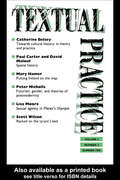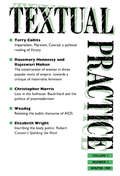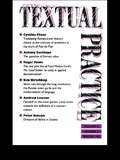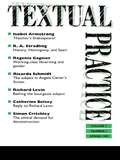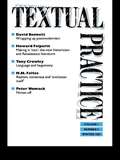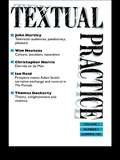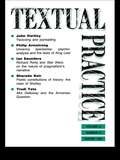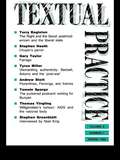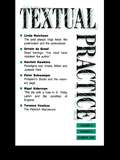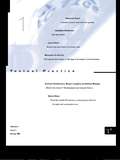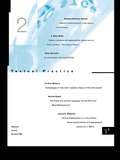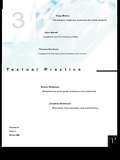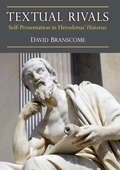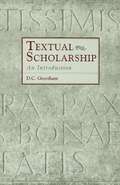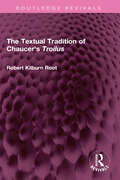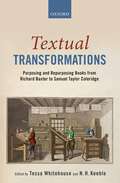- Table View
- List View
Textual Practice: Issue 8 Volume 3 No. 2
by Terence HawkesThis book should be of interest to students and teachers of literature and literary theory.
Textual Practice: Issue 9 Volume 3 No. 3
by Terence HawkesThis book should be of interest to students and teachers of literature and literary theory.
Textual Practice: Volume 4, Issue 3
by Terence HawkesFirst published in 1990. Routledge is an imprint of Taylor & Francis, an informa company.
Textual Practice: Issue 8 Volume 3 No. 2
by Terence HawkesThis book should be of interest to students and teachers of literature and literary theory.
Textual Practice: Issue 7 Volume 3 No. 1
by Terence HawkesFirst Published in 1989. Routledge is an imprint of Taylor & Francis, an informa company.
Textual Practice: Issue 9 Volume 3 No. 3
by Terence HawkesThis book should be of interest to students and teachers of literature and literary theory.
Textual Practice
by Terence HawkesFirst Published in 1987. Routledge is an imprint of Taylor & Francis, an informa company.
Textual Practice
by Terence HawkesFirst Published in 1987. Routledge is an imprint of Taylor & Francis, an informa company.
Textual Practice
by Terence HawkesFirst Published in 1987. Routledge is an imprint of Taylor & Francis, an informa company.
Textual Practice
by Terence HawkesFirst Published in 1987. Routledge is an imprint of Taylor & Francis, an informa company.
Textual Practice: Volume 8, Issue 3
by Terence Hawkes Jean HowardFirst published in 1994. Routledge is an imprint of Taylor & Francis, an informa company.
Textual Practice: Volume 8, Issue 1
by Terence Hawkes Jean HowardFirst published in 1994. Routledge is an imprint of Taylor & Francis, an informa company.
Textual Practice: Volume 8, Issue 2
by Terence Hawkes Jean HowardFirst published in 1994. Routledge is an imprint of Taylor & Francis, an informa company.
Textual Practice: Volume 9 Issue 1
by Alan SinfieldFirst published in 1995. Routledge is an imprint of Taylor & Francis, an informa company.
Textual Practice: Volume 9 Issue 2
by Lindsay Deputy Editor Smith Alan Sinfield Jean Us Associate Editor HowardFirst published in 1995. Routledge is an imprint of Taylor & Francis, an informa company.
Textual Practice: Volume 9 Issue 1
by Lindsay Deputy Editor Smith Alan Sinfield Jean Us Associate Editor HowardFirst published in 1995. Routledge is an imprint of Taylor & Francis, an informa company.
Textual Practice 10.3
by Vijay Mishra John Barrell Thomas Docherty Simon Shepherd Jonathan DollimorePapers include: Tragedy and the nationalist condition of criticism "Thomas Doucherty"--Descartes, Baudrillard, Dryden and a consideration of cultural relations between England and France in the late seventeenth century.ILaodamia and the moaning of Mary "John" "Barrell"--changing critical responses to Wordsworth's "heroic version of masculinity." Melodrama as Avant-garde: enacting a new subjectivity "Simon Shepherd"--nineteenth-century English radicals and translations of French melodrama. The diasporic imaginary: theorizing the Indian diaspora "Vijay Mishra;" Bisexuality, heterosexuality and wishful theory "Jonathan Dollimore. Reviews, index. Holcroft ""IA Tale of Mystery, --a melo-drame" and ICaleb Williams
Textual Practice 10.3
by Alan SinfieldPapers include: Tragedy and the nationalist condition of criticism "Thomas Doucherty"--Descartes, Baudrillard, Dryden and a consideration of cultural relations between England and France in the late seventeenth century.ILaodamia and the moaning of Mary "John" "Barrell"--changing critical responses to Wordsworth's "heroic version of masculinity." Melodrama as Avant-garde: enacting a new subjectivity "Simon Shepherd"--nineteenth-century English radicals and translations of French melodrama. The diasporic imaginary: theorizing the Indian diaspora "Vijay Mishra;" Bisexuality, heterosexuality and wishful theory "Jonathan Dollimore. Reviews, index. Holcroft ""IA Tale of Mystery, --a melo-drame" and ICaleb Williams
Textual Rivals: Self-Presentation in Herodotus’ Histories
by David BranscomeTextual Rivals studies some of the most debated issues in Herodotean scholarship. One such is Herodotus’ self-presentation: the conspicuousness of his authorial persona is one of the most remarkable features of his Histories. So frequently does he interject first-person comments into the narrative that Herodotus at times almost becomes a character within his own text. Important issues are tied to Herodotus’ self-presentation. First is the narrator’s relationship to truth: to what extent does he expect readers to trust his narrative? While judgments regarding Herodotus’ overall veracity have often been damning, scholars have begun to concentrate on how Herodotus presents his truthfulness. Second is the precise genre Herodotus means to create with his work. Excluding the anachronistic term historian, exactly what would Herodotus have called himself, as author? Third is the presence of “self-referential” characters, whose actions often mirror Herodotus’ as narrator/researcher, in the Histories. David Branscome’s investigative text points to the rival inquirers in Herodotus’ Histories as a key to unraveling these interpretive problems. The rival inquirers are self-referential characters Herodotus uses to further his authorial self-presentation. Through the contrast Herodotus draws between his own exacting standards as an inquirer and the often questionable standards of those rivals, Herodotus underlines just how truthful readers should find his own work. Textual Rivals speaks to those interested in Greek history and historiography, narratology, and ethnography. Those in the growing ranks of Herodotus fans will find much to invite and intrigue.
Textual Scholarship: An Introduction
by David GreethamThis fully revised and updated edition of the bestselling "Textual Scholarship" covers all aspects of textual theory and scholarly editing for students and scholars. As the definitive introduction to the skills of textual scholarship, the new edition addresses the revolutionary shift from print to digital textuality and subsequent dramatic changes in the emphasis and direction of textual enquiry.
Textual Scholarship: An Introduction (Text: An Interdisciplinary Annual Of Textual Studies)
by David GreethamThis fully revised and updated edition of the bestselling "Textual Scholarship" covers all aspects of textual theory and scholarly editing for students and scholars. As the definitive introduction to the skills of textual scholarship, the new edition addresses the revolutionary shift from print to digital textuality and subsequent dramatic changes in the emphasis and direction of textual enquiry.
The Textual Tradition of Chaucer's Troilus (Routledge Revivals)
by Robert Kilburn RootFirst published in 1916, The Textual Tradition of Chaucer’s Troilus compares the best unprinted manuscripts of Chaucer’s Troilus with the printed texts. The purpose of the volume is to evaluate eighteen manuscripts, to determine so far as may be their relation to one another and to Chaucer’s original, and to show how they are to be used for the establishing of a critical text. This book will be of interest to students of literature, linguistics and history.
The Textual Tradition of Chaucer's Troilus (Routledge Revivals)
by Robert Kilburn RootFirst published in 1916, The Textual Tradition of Chaucer’s Troilus compares the best unprinted manuscripts of Chaucer’s Troilus with the printed texts. The purpose of the volume is to evaluate eighteen manuscripts, to determine so far as may be their relation to one another and to Chaucer’s original, and to show how they are to be used for the establishing of a critical text. This book will be of interest to students of literature, linguistics and history.
Textual Transformations: Purposing and Repurposing Books from Richard Baxter to Samuel Taylor Coleridge
by N. H. Keeble Tessa WhitehouseEarly modern books were not stable or settled outputs of the press but dynamic shape-changers, subject to reworking, re-presentation, revision, and reinterpretation. Their history is often the history of multiple, sometimes competing, agencies as their texts were re-packaged, redirected, and transformed in ways that their original authors might hardly recognize. Processes of editing, revision, redaction, selection, abridgement, glossing, disputation, translation, and posthumous publication resulted in a textual elasticity and mobility that could dissolve distinctions between text and paratexts, textuality and intertextuality, manuscript and print, author and reader or editor, such that title and author's name are no longer sufficient pointers to a book's identity or contents. This collection brings together original essays by an international team of eminent scholars in the field of book history that explore these various kinds of textual inconstancy and variability. The essays are alive to the impact of commercial and technological aspects of book production and distribution (discussing, for example, the career of the pre-eminent bookseller John Nourse, the market appeal of abridgements, and the financial incentives to posthumous publication), but their interest is also in the many additional forms of agency that shaped texts and their meanings as books were repurposed to articulate, and respond to, a variety of cultural and individual needs. They engage with early modern religious, political, philosophical, and scholarly trends and debates as they discuss a wide range of genres and kinds of publication including fictional and non-fictional prose, verse miscellanies, abridgements, sermons, religious controversy, and of authors including Lucy Hutchinson, Richard Baxter, John Dryden, Thomas Burnet, John Tillotson, Henry Maundrell, Jonathan Swift, Samuel Richardson, John Wesley, and Samuel Taylor Coleridge. The result is a richly diverse collection that demonstrates the embeddedness of the book trade in the cultural dynamics of early modernity.
Textual Transformations: Purposing and Repurposing Books from Richard Baxter to Samuel Taylor Coleridge
Early modern books were not stable or settled outputs of the press but dynamic shape-changers, subject to reworking, re-presentation, revision, and reinterpretation. Their history is often the history of multiple, sometimes competing, agencies as their texts were re-packaged, redirected, and transformed in ways that their original authors might hardly recognize. Processes of editing, revision, redaction, selection, abridgement, glossing, disputation, translation, and posthumous publication resulted in a textual elasticity and mobility that could dissolve distinctions between text and paratexts, textuality and intertextuality, manuscript and print, author and reader or editor, such that title and author's name are no longer sufficient pointers to a book's identity or contents. This collection brings together original essays by an international team of eminent scholars in the field of book history that explore these various kinds of textual inconstancy and variability. The essays are alive to the impact of commercial and technological aspects of book production and distribution (discussing, for example, the career of the pre-eminent bookseller John Nourse, the market appeal of abridgements, and the financial incentives to posthumous publication), but their interest is also in the many additional forms of agency that shaped texts and their meanings as books were repurposed to articulate, and respond to, a variety of cultural and individual needs. They engage with early modern religious, political, philosophical, and scholarly trends and debates as they discuss a wide range of genres and kinds of publication including fictional and non-fictional prose, verse miscellanies, abridgements, sermons, religious controversy, and of authors including Lucy Hutchinson, Richard Baxter, John Dryden, Thomas Burnet, John Tillotson, Henry Maundrell, Jonathan Swift, Samuel Richardson, John Wesley, and Samuel Taylor Coleridge. The result is a richly diverse collection that demonstrates the embeddedness of the book trade in the cultural dynamics of early modernity.
